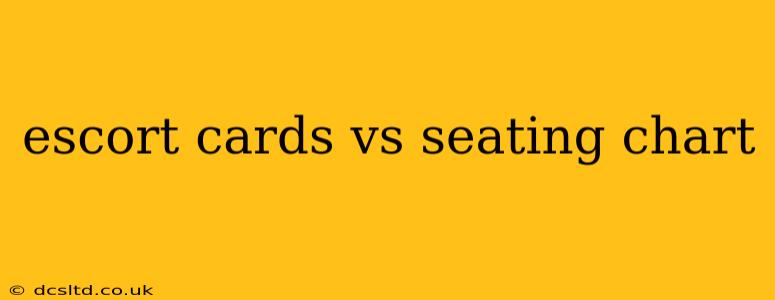Planning a wedding involves a myriad of decisions, and one often overlooked yet crucial element is how you'll guide your guests to their seats. This decision often boils down to choosing between escort cards and a seating chart. Both serve the same fundamental purpose – directing guests to their assigned tables – but they offer distinct aesthetic and logistical advantages. This comprehensive guide will delve into the key differences between escort cards and seating charts, helping you choose the perfect solution for your wedding style and guest list size.
What is an Escort Card?
Escort cards are individual cards displaying each guest's name and their assigned table number. They are typically displayed on a table or stand, allowing guests to easily locate their card and find their assigned table. The beauty of escort cards lies in their versatility; they can be customized to perfectly reflect your wedding theme and style, from elegant calligraphy to playful designs.
What is a Seating Chart?
A seating chart is a larger display, usually a framed print or a visually appealing board, showing all the tables and the names of the guests seated at each table. This method provides a clear overview of the entire seating arrangement. Seating charts are often more visually impactful, especially for larger weddings, and can create a focal point at the reception venue.
Escort Cards vs. Seating Charts: A Detailed Comparison
Choosing between escort cards and a seating chart depends heavily on your personal preferences and the specifics of your wedding. Let's compare them across several key aspects:
Guest List Size:
- Escort Cards: Ideal for smaller to medium-sized weddings (under 150 guests). Larger numbers can become cumbersome to manage and display.
- Seating Charts: Better suited for larger weddings (over 150 guests). They provide a more efficient and easily navigable way to direct a larger crowd.
Aesthetic & Style:
- Escort Cards: Offer a wide range of customization options, allowing for greater creativity and personalization to match your wedding theme.
- Seating Charts: Can serve as a striking visual element, adding to the overall ambiance and design of your reception. They also allow for creative presentation, using varied materials and formats.
Ease of Use:
- Escort Cards: Guests generally find escort cards easy to use. They simply search for their name and follow the table number to their designated place.
- Seating Charts: Can be slightly more challenging for guests, particularly if the chart is large or complex, requiring them to scan and find their name amongst others.
Cost:
- Escort Cards: The cost per guest is generally lower than a large, custom-made seating chart. However, the overall cost can still add up depending on the materials and design.
- Seating Charts: Can be more expensive upfront due to the cost of materials, framing, and potentially professional design services.
What if I have a mix of single and coupled guests?
Both escort cards and seating charts can accommodate couples and singles. For escort cards, you would simply list each guest's name individually. For seating charts, the chart will clearly show each guest's placement at a table.
Are there any alternatives to traditional escort cards and seating charts?
Yes! Creative alternatives include using place cards at each table, a digital seating chart displayed on a screen, or even a fun, interactive seating plan game.
Which is more formal?
Both can be formal or informal depending on the presentation. Elegant calligraphy on escort cards or a beautifully framed seating chart create a formal feel, whereas simpler designs can offer a more casual approach.
Conclusion: The Best Choice for You
Ultimately, the best choice between escort cards and a seating chart depends on your individual needs and preferences. Consider your guest count, budget, wedding style, and desired level of formality when making your decision. By weighing these factors carefully, you can choose the option that best complements your wedding and ensures your guests have a smooth and enjoyable experience.
